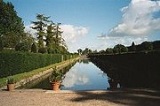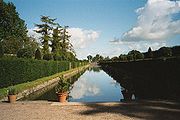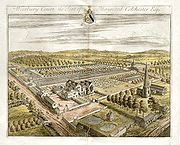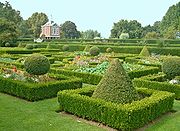
Westbury Court Garden
Encyclopedia

Dutch garden
The Dutch garden is distinguished by its dense atmosphere and efficient use of space. On an international level, a garden with tulips is also easily labelled as a Dutch Garden....
water garden
Water garden
Water gardens, also known as aquatic gardens, are a type of man-made water feature. A water garden is defined as any interior or exterior landscape or architectural element whose primarily purpose is to house, display, or propagate a particular species or variety of aquatic plant...
in Westbury-on-Severn
Westbury-on-Severn
Westbury-on-Severn is a rural village in England that is the centre of the large, rural parish, also called Westbury-on-Severn.-Location:The village is situated on the A48 road and bounded by the River Severn to the south and west.The village has a large parish church which is distinctive as the...
, Gloucestershire
Gloucestershire
Gloucestershire is a county in South West England. The county comprises part of the Cotswold Hills, part of the flat fertile valley of the River Severn, and the entire Forest of Dean....
, England
England
England is a country that is part of the United Kingdom. It shares land borders with Scotland to the north and Wales to the west; the Irish Sea is to the north west, the Celtic Sea to the south west, with the North Sea to the east and the English Channel to the south separating it from continental...
, 9 miles (14.5 km) southwest of Gloucester
Gloucester
Gloucester is a city, district and county town of Gloucestershire in the South West region of England. Gloucester lies close to the Welsh border, and on the River Severn, approximately north-east of Bristol, and south-southwest of Birmingham....
.
It was laid out in 1696–1705, a rare survival not to have been replaced in the 18th century by a naturalistic garden landscape as popularised by Capability Brown
Capability Brown
Lancelot Brown , more commonly known as Capability Brown, was an English landscape architect. He is remembered as "the last of the great English eighteenth-century artists to be accorded his due", and "England's greatest gardener". He designed over 170 parks, many of which still endure...
. It is situated facing the high street of the rural village, extending on low-lying water meadows adjacent to the River Severn
River Severn
The River Severn is the longest river in Great Britain, at about , but the second longest on the British Isles, behind the River Shannon. It rises at an altitude of on Plynlimon, Ceredigion near Llanidloes, Powys, in the Cambrian Mountains of mid Wales...
; the flat watery ground makes the site well suited to a Dutch-style garden
Dutch garden
The Dutch garden is distinguished by its dense atmosphere and efficient use of space. On an international level, a garden with tulips is also easily labelled as a Dutch Garden....
, of which Westbury is the outstanding survival in Britain.
The garden's centrepiece is a 137 metres (449.5 ft) long canal
Canal
Canals are man-made channels for water. There are two types of canal:#Waterways: navigable transportation canals used for carrying ships and boats shipping goods and conveying people, further subdivided into two kinds:...
(illustration, right), centred on a two-storey Dutch style
Dutch Golden Age
The Golden Age was a period in Dutch history, roughly spanning the 17th century, in which Dutch trade, science, military and art were among the most acclaimed in the world. The first half is characterised by the Eighty Years' War till 1648...
red-brick pavilion
Pavilion (structure)
In architecture a pavilion has two main meanings.-Free-standing structure:Pavilion may refer to a free-standing structure sited a short distance from a main residence, whose architecture makes it an object of pleasure. Large or small, there is usually a connection with relaxation and pleasure in...
at one end and a large wrought iron
Wrought iron
thumb|The [[Eiffel tower]] is constructed from [[puddle iron]], a form of wrought ironWrought iron is an iron alloy with a very low carbon...
gate in the wall at the far end, designed to extend the vista from the pavilion out into the surrounding countryside. The main canal is flanked by yew
Taxus baccata
Taxus baccata is a conifer native to western, central and southern Europe, northwest Africa, northern Iran and southwest Asia. It is the tree originally known as yew, though with other related trees becoming known, it may be now known as the English yew, or European yew.-Description:It is a small-...
and holly
Holly
Ilex) is a genus of 400 to 600 species of flowering plants in the family Aquifoliaceae, and the only living genus in that family. The species are evergreen and deciduous trees, shrubs, and climbers from tropics to temperate zones world wide....
topiary
Topiary
Topiary is the horticultural practice of training live perennial plants, by clipping the foliage and twigs of trees, shrubs and subshrubs to develop and maintain clearly defined shapes, perhaps geometric or fanciful; and the term also refers to plants which have been shaped in this way. It can be...
in pyramids and balls. A second red-brick building, a summer house
Summer house
A summer house or summerhouse has traditionally referred to a building or shelter used for relaxation in warm weather. This would often take the form of a small, roofed building on the grounds of a larger one, but could also be built in a garden or park, often designed to provide cool shady places...
built in 1702–04, overlooks a T-shaped canal running parallel to the main canal. Behind the summer house is a small walled garden of cottage plants and beyond the water garden is an orchard of fruit trees, which also contains an ancient evergreen oak
Live oak
Live oak , also known as the southern live oak, is a normally evergreen oak tree native to the southeastern United States...
planted in the 17th century, the largest ever recorded, it is also claimed to be the oldest in England
England
England is a country that is part of the United Kingdom. It shares land borders with Scotland to the north and Wales to the west; the Irish Sea is to the north west, the Celtic Sea to the south west, with the North Sea to the east and the English Channel to the south separating it from continental...
.

Robert Atkyns (topographer)
Sir Robert Atkyns was a topographer, antiquary, and Member of Parliament. He is best known for his county history, the Ancient and Present State of Gloucestershire.-Life:...
' The Ancient and Present State of Gloucester.
The garden at Westbury was created by the owner of Westbury Court, Maynard Colchester I, between 1697, when the brook was first diverted, and 1705. Impetus may have been provided by the canal garden nearby at Flaxley Abbey
Flaxley Abbey
Flaxley Abbey is a former Cistercian monastery in England, now a private residence, in the Forest of Dean, Gloucestershire.-History:Flaxley Abbey was founded in 1148 by Roger Fitzmiles, 2nd Earl of Hereford...
, which was the seat of Colchester's close friend Catharina Boevey, the widow of William Boevey, member of a Dutch merchant family settled at London; Kip's engraving of Flaxley shows a long rectangular canal, of which only traces remain. Clipped accents to set off the pyramidal yews were provided by 'headed' Laurustinus, headed and pyramidal Phillyrea
Phillyrea
Phillyrea is a genus of two species of flowering plants in the family Oleaceae, native to the Mediterranean region, the Canary Islands and Madeira....
and "Mizerean trees
Daphne mezereum
Daphne mezereum is a species of Daphne in the flowering plant family Thymelaeaceae, native to most of Europe and Western Asia, north to northern Scandinavia and Russia. In southern Europe it is confined to medium to higher elevations and in the subalpine vegetation zone, but descends to near sea...
" in sixes and pairs.

Maynard Colchester II also demolished the original late Elizabethan
Elizabethan architecture
Elizabethan architecture is the term given to early Renaissance architecture in England, during the reign of Queen Elizabeth I. Historically, the period corresponds to the Cinquecento in Italy, the Early Renaissance in France, and the Plateresque style in Spain...
manor house
Manor house
A manor house is a country house that historically formed the administrative centre of a manor, the lowest unit of territorial organisation in the feudal system in Europe. The term is applied to country houses that belonged to the gentry and other grand stately homes...
of Westbury Court in the 1740s and built a Palladian
Palladian architecture
Palladian architecture is a European style of architecture derived from the designs of the Venetian architect Andrea Palladio . The term "Palladian" normally refers to buildings in a style inspired by Palladio's own work; that which is recognised as Palladian architecture today is an evolution of...
mansion in its stead, to designs of a little-known mason of Bristol
Bristol
Bristol is a city, unitary authority area and ceremonial county in South West England, with an estimated population of 433,100 for the unitary authority in 2009, and a surrounding Larger Urban Zone with an estimated 1,070,000 residents in 2007...
, Michael Sidnell. This was in turn replaced by a 19th century country house, no longer standing.
By 1967, with the manor house gone and the garden derelict, the National Trust
National Trust for Places of Historic Interest or Natural Beauty
The National Trust for Places of Historic Interest or Natural Beauty, usually known as the National Trust, is a conservation organisation in England, Wales and Northern Ireland...
— who had never been responsible for a garden restoration before — accepted the care of Westbury Court Garden.. Miles Hadfield, then president of the Garden History Society, was influential in persuading the Trust to do so. In 1971, work started on the restoration with aid of Colchester's meticulous accounts, Kip's engravings and the evidence on the ground. Authenticity was paramount: in the water garden only plants introduced before 1700 were used.

